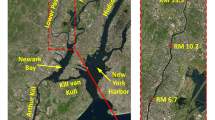Abstract
Estuaries and coastal bays frequently receive anthropogenically sourced contaminants. Many of these contaminants (e.g. most metals) have low solubility and tend to sorb to sediment particles, so that sediment transport driven by fluid mechanics becomes an important part of the contaminant transport problem. The chosen strategy for mitigation of the contaminant(s) will depend on the potential for migration away from the affected region, or the build-up of concentrations within the receiving area if loading rate exceeds decay or transport rates, and the potential impact on environmental and human health both within and outside the receiving area.
Two case studies are considered here in which data describing instantaneous contaminant concentrations in estuarine environments were acquired via field sampling. Both sites feature estuaries dominated by tidal forcing, with smaller, adjacent upland regions also impacted. Metals, particularly copper and lead, are the primary focus in each case. Contaminant transport processes, including diffusion, advection, and bioturbation, are treated together to develop analytical and numerical solutions for time-dependent contaminant concentrations using a spatially varying, time-dependent, effective diffusion coefficient that is influenced by local surface water flow speeds. Different initial, boundary, and loading conditions are considered to illustrate the relative importance of the various transport processes. Implications of future contaminant loading and sea level rise scenarios are demonstrated and discussed.










Similar content being viewed by others
References
Bicknell BR, Imhoff JC, Kittle JL, Donigian AS, Johanson RC (1993) Hydrological Simulation Program—FORTRAN (HSPF): users manual for release 10. EPA-600/R-93/174, US EPA, Athens, GA, 30605
Çengel YA (2008) Introduction to thermodynamics and heat transfer, 2nd edn. McGraw-Hill, New York
DiToro DM, Zarba CS, Hansen DJ, Berry WJ, Swartz RC, Cowan CE, Pavlou SP, Allen HE, Thomas NA, Paquin PR (1991) Technical basis for establishing sediment quality criteria for nonionic organic chemicals by using equilibrium partitioning. Environ Toxicol Chem 10(l2):1541–1586
Ford RG, Wilkin RT, Paul CJ, Beck F, Lee T (2005) Field study of the fate of arsenic, lead, and zinc at the ground-water/surface-water Interface. EPA report EPA/600/R-05/161
Johnson MS, Wickwire WT, Quinn MJ, Ziolkowski DJ, Burmistrov D, Menzie CA, Geraghty C, Minnich M, Parsons PJ (2007) Are songbirds at risk from lead at small arms ranges? An application of the spatially explicit exposure model (SEEM). Environ Toxicol Chem 26(10):2215–2225
Kuwabara JS, Berelson WM, Balistrieri LS, Woods PF, Topping BR, Steding DJ, Krabbenhoft DP (1999) Benthic flux of metals and nutrients into the water column of Lake Coeur d’Alene, Idaho. US Geological Survey, Water-resources investigations report 00-4132
Kuwabara JS, Dipasquale MM, Praskins W, Byron E, Topping BR, Carter JL, Fend SV, Parchaso F, Krabbenhoft DP, Gustin MS (2001) Flux of dissolved forms of mercury across the sediment-water interface in Lahontan Reservoir, Nevada. US Geological Survey, Water resources investigations report 02-4138
Litz B (2009) Applied ballistics for long range shooting. Applied Ballistics, LLC
Liu C, Ball WP (1998) Analytical modeling of diffusion-limited contamination and decontamination in a two-layer porous medium. Adv Water Resour 21:297–313
Simpson G, Schlunegger F (2003) Topographic evolution and morphology of surfaces evolving in response to coupled fluvial and hillslope sediment transport. J Geophys Res 108(2300):16. doi:10.1029/2002JB002162
US EPA (1998) Method 6200: field portable X-ray fluorescence spectrometry for the determination of elemental concentrations in soils and sediments, revision 0, January
US EPA (2005) Procedures for the derivation of Equilibrium Partitioning Sediment Benchmarks (ESBs) for the protection of benthic organisms: metal mixtures (cadmium, copper, lead, nickel, silver and zinc). EPA-600-R-02-011. Office of research and development. Washington, DC
Wolf D (2012) The basics of risk assessment to protect human health and the environment. In: 1st international course-seminar of environmental toxicological pathology, August 23–24
Work PA, Moore P, Reible DD (2002) Bioturbation, advection and diffusion of a conserved contaminant in a laboratory flume. J Water Resour Res Am Geophys Union 38(6):24-1–24-9
Zhuang Y (1997) A semianalytical solution to a diffusion-deposition-resuspension model of local contamination. Atomic Energy of Canada Limited, Chalk River
Acknowledgements
This work was funded by the US Marine Corps under contract no. W31RY072216980 to DAW and administered through the Piedmont-South Atlantic Coast Cooperative Ecosystem Studies Unit, of which DoD is a member agency. The authors could like to acknowledge assitance from Hannuman Bull, Kemal Cambazoğlu, Zafer Defne, Thomas Gay, Heidi Hammerstein, Ashley Randall, Adam Sapp, Hampton Simpkins, and Stephanie Smallegan in completing the field work and subsequent sample and data analysis.
Author information
Authors and Affiliations
Corresponding author
Rights and permissions
About this article
Cite this article
Work, P.A., Haas, K.A., Warren, D.A. et al. Assessment and Transport of Sediment-Bound Estuarine Contaminants. Water Qual Expo Health 7, 5–14 (2015). https://doi.org/10.1007/s12403-013-0101-7
Received:
Accepted:
Published:
Issue Date:
DOI: https://doi.org/10.1007/s12403-013-0101-7




